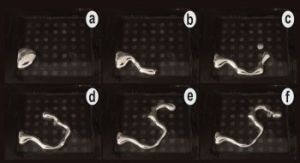Oct 18 2017
Researchers at Swansea University and the University of Sussex have used electrical charges to morph liquid metal into 2D shapes such as a heart and letters.
 A blob of liquid metal morphs into the letter S using programmable electrical charges. Credit: University of Sussex
A blob of liquid metal morphs into the letter S using programmable electrical charges. Credit: University of Sussex
The research team stated that the findings denote an “extremely promising” new type of materials that can be programmed to change shape seamlessly. This opens up new possibilities in shape-changing displays and ‘soft robotics’, according to Researchers.
Although the discovery might recall the film Terminator 2, where the title character transforms from a pool of liquid metal, the design of 3D shapes is still some way off. More direct applications could include conductive ink and reprogrammable circuit boards.
This is a new class of programmable materials in a liquid state which can dynamically transform from a simple droplet shape to many other complex geometry in a controllable manner. While this work is in its early stages, the compelling evidence of detailed 2D control of liquid metals excites us to explore more potential applications in computer graphics, smart electronics, soft robotics and flexible displays.
Yutaka Tokuda, Research Associate, University of Sussex
The electric fields employed to shape the liquid are made by a computer, meaning that the shape and position of the liquid metal can be programmed and managed dynamically.
Liquid metals are an extremely promising class of materials for deformable applications; their unique properties include voltage-controlled surface tension, high liquid-state conductivity and liquid-solid phase transition at room temperature. One of the long-term visions of us and many other researchers is to change the physical shape, appearance and functionality of any object through digital control to create intelligent, dexterous and useful objects that exceed the functionality of any current display or robot.
Professor Sriram Subramanian, Head of the INTERACT Lab, The University of Sussex
The research findings were presented on 17th October at the ACM Interactive Surfaces and Spaces 2017 conference held in Brighton.
This evening from 7pm to 10pm, a live demonstration is taking place at the Jury’s Inn Brighton Waterfront.
This project titled “Breaking the Glass: Multimodal, Malleable Interactive Mobile surfaces for Hands-In Interactions” is a joint venture between Swansea and Sussex, and funded EPSRC.
Programmable Liquid Matter : Shape Deformation of Liquid Metals in Dynamic Electric Field